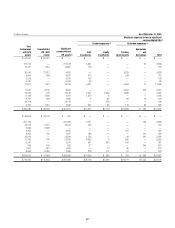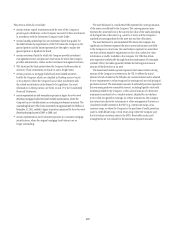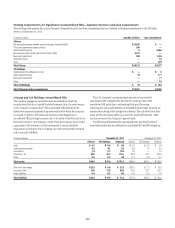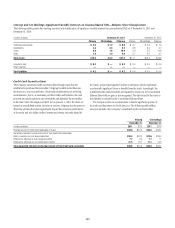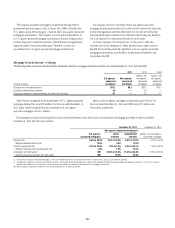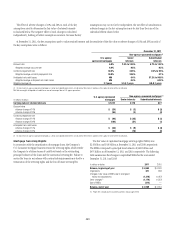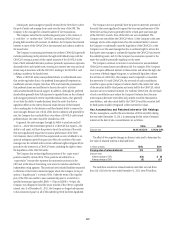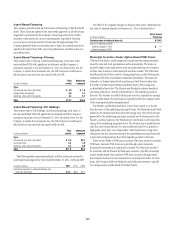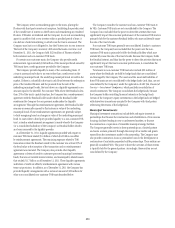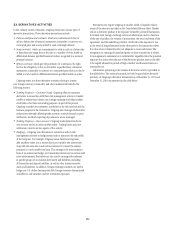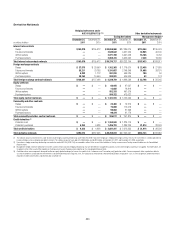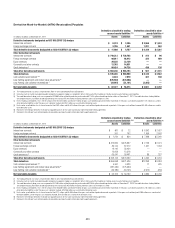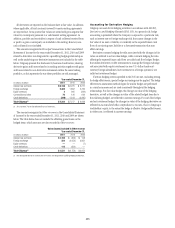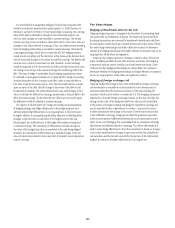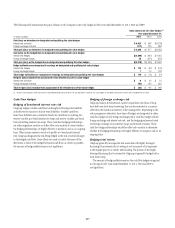Citibank 2011 Annual Report Download - page 249
Download and view the complete annual report
Please find page 249 of the 2011 Citibank annual report below. You can navigate through the pages in the report by either clicking on the pages listed below, or by using the keyword search tool below to find specific information within the annual report.227
Finally, the Company is one of several named dealers in the commercial
paper issued by the conduits and earns a market-based fee for providing
such services. Along with third-party dealers, the Company makes a market
in the commercial paper and may from time to time fund commercial
paper pending sale to a third party. On specific dates with less liquidity in
the market, the Company may hold in inventory commercial paper issued
by conduits administered by the Company, as well as conduits administered
by third parties. The amount of commercial paper issued by its administered
conduits held in inventory fluctuates based on market conditions and
activity. As of December 31, 2011, the Company owned $144 million of the
commercial paper issued by its unconsolidated administered conduit.
With the exception of the government-guaranteed loan conduit described
below, the asset-backed commercial paper conduits are consolidated by the
Company. The Company determined that through its role as administrator
it had the power to direct the activities that most significantly impacted the
entities’ economic performance. These powers included its ability to structure
and approve the assets purchased by the conduits, its ongoing surveillance
and credit mitigation activities, and its liability management. In addition, as
a result of all the Company’s involvement described above, it was concluded
that the Company had an economic interest that could potentially be
significant. However, the assets and liabilities of the conduits are separate and
apart from those of Citigroup. No assets of any conduit are available to satisfy
the creditors of Citigroup or any of its other subsidiaries.
The Company administers one conduit that originates loans to
third-party borrowers and those obligations are fully guaranteed primarily
by AAA-rated government agencies that support export and development
financing programs. The economic performance of this government-
guaranteed loan conduit is most significantly impacted by the performance
of its underlying assets. The guarantors must approve each loan held by
the entity and the guarantors have the ability (through establishment of
the servicing terms to direct default mitigation and to purchase defaulted
loans) to manage the conduit’s loans that become delinquent to improve the
economic performance of the conduit. Because the Company does not have
the power to direct the activities of this government-guaranteed loan conduit
that most significantly impact the economic performance of the entity, it
was concluded that the Company should not consolidate the entity. The
total notional exposure under the program-wide liquidity agreement for the
Company’s unconsolidated administered conduit as of December 31, 2011
is $0.6 billion. The program-wide liquidity agreement, along with each
asset APA, is considered in the Company’s maximum exposure to loss to the
unconsolidated administered conduit.
As of December 31, 2011, this unconsolidated government-guaranteed
loan conduit held assets of approximately $13.0 billion.
Third-Party Commercial Paper Conduits
The Company also provides liquidity facilities to single- and multi-seller
conduits sponsored by third parties. These conduits are independently owned
and managed and invest in a variety of asset classes, depending on the nature
of the conduit. The facilities provided by the Company typically represent a
small portion of the total liquidity facilities obtained by each conduit, and
are collateralized by the assets of each conduit. As of December 31, 2011,
the notional amount of these facilities was approximately $746 million, of
which $448 million was funded under these facilities. The Company is not
the party that has the power to direct the activities of these conduits that
most significantly impact their economic performance and thus does not
consolidate them.
Collateralized Debt and Loan Obligations
A securitized collateralized debt obligation (CDO) is an SPE that purchases
a pool of assets consisting of asset-backed securities and synthetic exposures
through derivatives on asset-backed securities and issues multiple tranches of
equity and notes to investors.
A cash CDO, or arbitrage CDO, is a CDO designed to take advantage of
the difference between the yield on a portfolio of selected assets, typically
residential mortgage-backed securities, and the cost of funding the CDO
through the sale of notes to investors. “Cash flow” CDOs are entities in which
the CDO passes on cash flows from a pool of assets, while “market value”
CDOs pay to investors the market value of the pool of assets owned by the
CDO at maturity. In these transactions, all of the equity and notes issued by
the CDO are funded, as the cash is needed to purchase the debt securities.
A synthetic CDO is similar to a cash CDO, except that the CDO obtains
exposure to all or a portion of the referenced assets synthetically through
derivative instruments, such as credit default swaps. Because the CDO does
not need to raise cash sufficient to purchase the entire referenced portfolio, a
substantial portion of the senior tranches of risk is typically passed on to CDO
investors in the form of unfunded liabilities or derivative instruments. Thus,
the CDO writes credit protection on select referenced debt securities to the
Company or third parties and the risk is then passed on to the CDO investors
in the form of funded notes or purchased credit protection through derivative
instruments. Any cash raised from investors is invested in a portfolio of
collateral securities or investment contracts. The collateral is then used to
support the obligations of the CDO on the credit default swaps written to
counterparties.
A securitized collateralized loan obligation (CLO) is substantially similar
to the CDO transactions described above, except that the assets owned by
the SPE (either cash instruments or synthetic exposures through derivative
instruments) are corporate loans and to a lesser extent corporate bonds,
rather than asset-backed debt securities.


